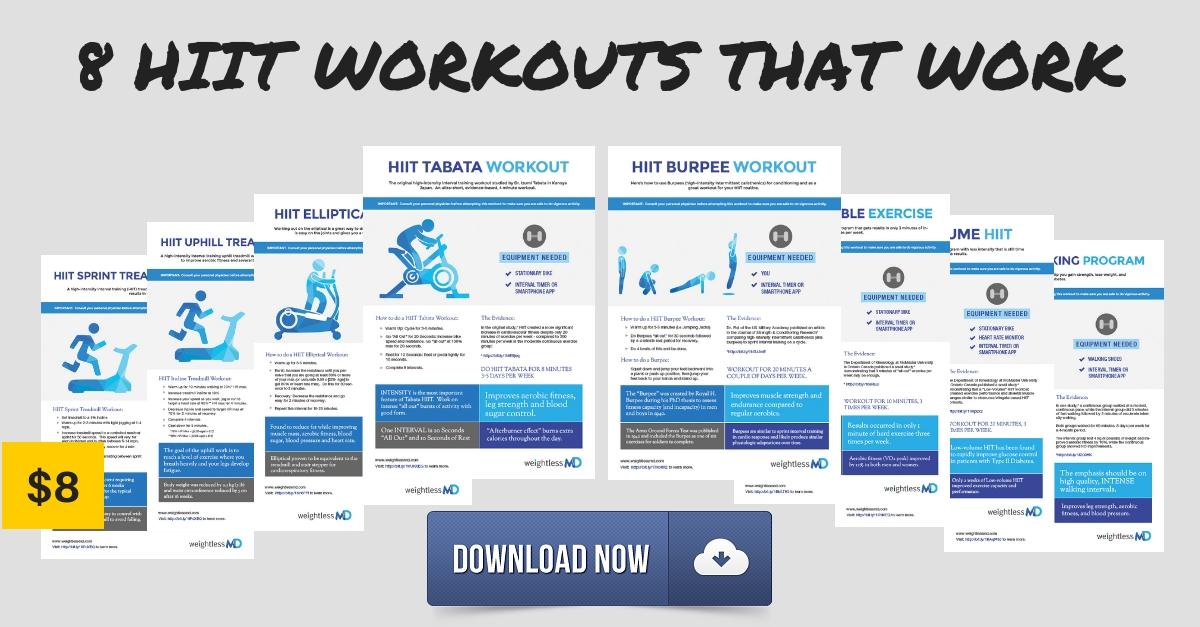An ultra-efficient high-intensity interval training (HIIT) workout routine in only 4 minutes.
What is a Tabata workout routine and how to get started.
The Tabata workout routine is a killer. This program is the ultimate in efficiency – only 4 minutes long.
Dr. Izumi Tabata, a researcher with the National Institute of Fitness and Sports in Kanoya, Japan studied high-intensity interval training on a cycle ergometer.
A paper he published in 1996 showed that an ultra-short interval routine was effective at increasing aerobic and anaerobic fitness in only 4 minutes of working out.
Yes, only 4 minutes.
I know this is hard to believe, but trust me . . . or at least trust the research.
Using a cycle ergometer, he studied participants doing continuous cycling. One group rode for 60 minutes at moderate intensity (70% of VO2 max) five days a week for a 6 week period.
This group was compared to a high-intensity interval group that did an “exhaustive intermittent training” consisting of 20 seconds of “all out” intensity of 100% max followed by 10 seconds of rest. They completed 8 bouts of this.
The total time of the HIIT Tabata workout was only 4 minutes!
The continuous group rode for 300 minutes per week, while the HIIT group rode only 20 minutes per week!
This is literally . . . unbelievable.
Especially given the results.
The HIIT group showed greater improvements in VO2max.
The HIIT group improved VO2max by 7 ml.kg-1.min-1 while the continuous group increased VO2max by 5 ml.kg-1.min-1.
The continuous exercise group had NO improvements in anaerobic threshold (which is how long it takes for your thighs to burn with lactic acid build up and a good measure of fitness).
The HIIT group improved their anaerobic threshold by 28%.
How to do a Tabata Workout Routine for high-intensity interval training.
First, you need to be prepared.
Mentally prepared because the routine may only be 4 minutes, but is challenging. The premise is to cause a burn . . . a painful build up of lactic acid in you quads.
You also need to be physically prepared.
The challenge is in the intensity. The study had participants sprinting on the cycle ergometer at 100% max.
So, you need to be prepared to go all out in order to get the benefits. I would only consider doing this routine if you are used to getting your heart rate up. Also, avoid going over you max heart rate.
The routine is a 2 to 1 ratio of work to rest.
The study technically used 20 seconds of all out intense cycling followed by 10 seconds of rest, which was light cycling.
As a beginner to Tabata, you could consider even shorter bursts such as 10 seconds of sprinting and 5 seconds of rest or any other 2 to 1 ratio you can make up and handle.
However, I would stick to 20:10 to be as close to the study as possible.
Related: High-Intensity Interval Training (HIIT): Elliptical Workout Routine
The program is designed to do 8 bouts for a total of 4 minutes.
As a beginner to this routine you could also consider cutting it in half and only doing 4 bouts of exercise. Do this for a week or two. You can gradually move up to 8 bouts as tolerated.
Now, because the timing is crucial to this program I would get either an interval timer or use the timer available on most smart phones.
There are also iPhone and android apps available to do this. For instance, there is the Tabata Timer online.
A watch could be used but is not always practical because it is difficult to time yourself while working so hard. Ideally you would have a trainer or partner time you.
A great idea would be to buddy-up for Tabata workouts.
How often should you do a Tabata workout routine?
Again, the study did the program 5 days a week.
Some believe it may not be practical to do this workout 5 days a week, but this is how the study was conducted. You may benefit from a day off between the workouts.
Many other studies did HIIT protocols of 3 days per week.
So, this is a difficult question to answer.
If you want to follow the protocol – stick to 5 days per week. I think this is doable because the program is so short and sweet.
Related: High-intensity Interval Training for Weight Loss
What equipment is needed for a Tabata HIIT workout?
A stationary bike or outdoor bike
The original study used an ergometer cycle. This is certainly where I would recommend starting.
Cycling really is ideal for HIIT programs.
The benefits of cycling is that it burns your thigh muscles so well. The thigh muscles are our largest muscle group. Cycling causes major muscle adaptations to increase in mitochndria that burn fat.
The muscle adaptations also help with insulin sensitivity.
There is little risk with injury on a stationary bike. You can certainly purchase a bike or use one at your local workout facility. The bike needs to be able to increase the resistance, which is widely available on commercial bikes.
You could also consider doing a Tabata routine in the outdoors on your bike while timing some sprints. This is less practical, but outdoor cycling is a natural HIIT activity.
A spin class would also be a great way to do a HIIT Tabata workout.
Your feet
Now, there are other ways to incorporate Tabata into your life. Tabata has developed into a national and worldwide movement that has completely distorted the original study.
Though this is not necessarily bad.
Beyond using an ergometer cycle, we really can only guess at whether the workout would give the same results.
An alternative way to to Tabata is sprints.
Get a good warm up and than sprint for 20 seconds, walk for 10 seconds and than sprint again. Eight rounds and done. I would avoid sprints if you have knee or ankle pain.
Again, the the bursts of intensity are paramount. So go hard!
Another, great way to do HIIT outside is to sprint up a hill. We have a hill in our back yard and this historically one of my favorite workouts (when I was a teenager I trained for football by running sprints up a hill).
Uphill sprints pound the quads hard and are a great alternative to the original study protocol.
Stairways also make a great HIIT Tabata workout. Go up hard and walk down.
Doing high-knees also works quite well. This is what I do on cold Minnesota days inside.
Related: Burpee Workout for High-Intensity Interval Training (HIIT)
A Tabata workout can be done at home with other equipment as well.
The Tabata routine has been used in weight lifting, jump roping, elliptical, kettle bells and almost any type or form of workout.
I think these variations stray far from the original study, and are more difficult to complete in the intensity that is required for Tabata HIIT routines. Not that it cannot be done, but cycling is safe at such high intensity. Swinging a kettle bell may be a bigger challenge.
So, be careful if you try these variations.
Finally, remember INTENSITY is the most important feature of Tabata HIIT. Work on quality, intense bursts of activity with good form.
Go hard and enjoy Tabata.
Summary:
Tabata Workout Benefits:
- Improved aerobic and anaerobic fitness and strength.
- Time efficient – Ultra-short workout in only 4 minutes.
- Improves insulin sensitivity likely improving blood sugar control
- HIIT causes release of norepinephrine and epinephrine that aids in fat burning.
- HIIT has an afterburner affect that lasts through the day burning more calories.
The Tabata Workout Routine:
- Warm up well for 3-5 minutes.
- Go “all out” at 100% heart rate max for 20 seconds.
- Rest or pedal lightly for 10 seconds.
- Repeat for 8 total bouts.
- Your done!
Related:
- High-intensity Interval Training for Weight Loss
- One Weight Lose Benefit of HIIT: Appetite Suppression
- High-Intensity Interval Training (HIIT): Elliptical Workout Routine
- Burpee Workout for High-Intensity Interval Training (HIIT)
- An Interval Walking Program: To lose weight, get strong and beat diabetes
The Evidence:
Tabata, et al. Effects of moderate-intensity endurance and high-intensity intermittent training on anaerobic capacity and VO2max. Medicine and Science in Sports and Exercise, 1996.
Image Credit: Vintage Racing Cycle from raumrot.com


